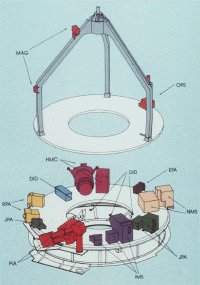Spacecraft
The most significant modification was the addition of a buffer to protect it from a battering by high speed dust particles during the comet encounter.
 |
 |
|
Giotto's payload |
Diagram of spacecraft |
By spacecraft standards, the 960-kg Giotto was quite modest in size. Its main body was a short cylinder 1.85 m in diameter by about 1.1 m in height. It contained three interior platforms: the top platform (30 cm thick), a main platform (40 cm), and an experiment platform (30 cm). Each of these consisted of a disc within the cylinder on which were mounted various subsystems and science experiments. On top of the cylinder was a tripod which surrounded a 1.5 m diameter high gain dish antenna and gave the spacecraft a total height of 2.85 m. The main rocket motor was positioned in the centre of the cylinder with the nozzle protruding from the bottom.
The most difficult problem to overcome was how to ensure that Giotto survived long enough to snap its close-up pictures of the nucleus when the spacecraft and the comet were heading towards each other at a combined speed of 245 000 kmh-1 (equivalent to crossing the Atlantic Ocean in 11 minutes!). At this speed, a 0.1 g dust particle would be able to penetrate 8 cm of solid aluminium. Since it was out of the question to equip Giotto with a 600 kg aluminium shield, engineers turned to a more subtle, sandwich design first proposed by American astronomer Fred Whipple back in 1947 - long before the beginning of the Space Age.
The spacecraft's dust shield consisted of two protective sheets, 23 cm apart. At the front was a sheet of aluminium (1 mm thick), which would vapourise all but the largest of the incoming dust particles. A 12 mm thick sheet of Kevlar at the rear would absorb any debris which pierced the front barrier. Together they could withstand impacts from particles up to 1 gram in mass and travelling 50 times faster than a bullet.
Electrical power came from a solar array which was made of 5032 silicon cells wrapped around its cylindrical exterior. These provided 190 Watts of power during the first comet encounter. Four silver-cadmium batteries were carried as back up and for use when the spacecraft was in shadow.
The spacecraft was spin-stabilised as it rotated at 15 rpm. During the encounter with Halley's Comet, the spacecraft approached with its dust shield and spin axis pointing towards the nucleus. Its dish antenna continually pointed at the Earth to ensure non-stop communications.
